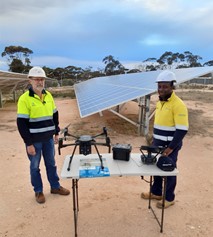As one of the state’s largest energy users, SA Water’s energy-intensive drinking water and wastewater pumping and treatment operations currently cost around $80 million each year.
The utility’s goal of a zero cost energy future is leading the Australian water industry, harnessing the power of green energy to neutralise one of their largest operating expenses and deliver sustainable environmental outcomes – equivalent to planting seven million trees.
SA Water embraced the opportunity to electrify their own energy sources and established 242 gigawatt hours (GWh) of solar arrays at 33 of their sites across South Australia, which require important ongoing maintenance to ensure optimal generation.
Water Engineering Technologies Condition Monitoring teams partnered with SA Water to deliver the Aerial Inspection Services (AIS) project, using drone technology to identify any faults at the solar arrays.
Drone-mounted infrared and high-definition cameras are used to collect photos and video data of the solar panel modules, improving inspections with greater efficiency and safety, while reducing operational expenses.
Lead Condition Monitoring Engineer Stephen Moore, and Condition Monitoring Officers Tim Tomo and Ian Hattersley, are our newly-skilled drone pilots, armed with the tools and training to deliver the new initiative, including acquiring their CASA (Civil Aviation Safety Authority) pilot licenses and software training to develop repeatable flight paths.
Embarking on their first solar inspection at Lobethal in April 2021, our team completed the task successfully.
“It was a huge success and we will continue to learn from each solar inspection,” Stephen said.
“Apart from increased inspection efficiency and reduced costs, drones can be used to simultaneously capture thermal and RGB data, which are both essential data sets providing a full picture to understanding any defects on solar panels.”
Nine solar inspections have been delivered to date, with the remaining solar sites scheduled for inspection during the next 12 months.
Investing in drones and digital technologies has enabled SA Water to increase solar generation, streamline on-site operational activities and maintain a portfolio of healthy solar arrays.

Water Engineering Technologies'
Ian Hattersley and Tim Tomo
